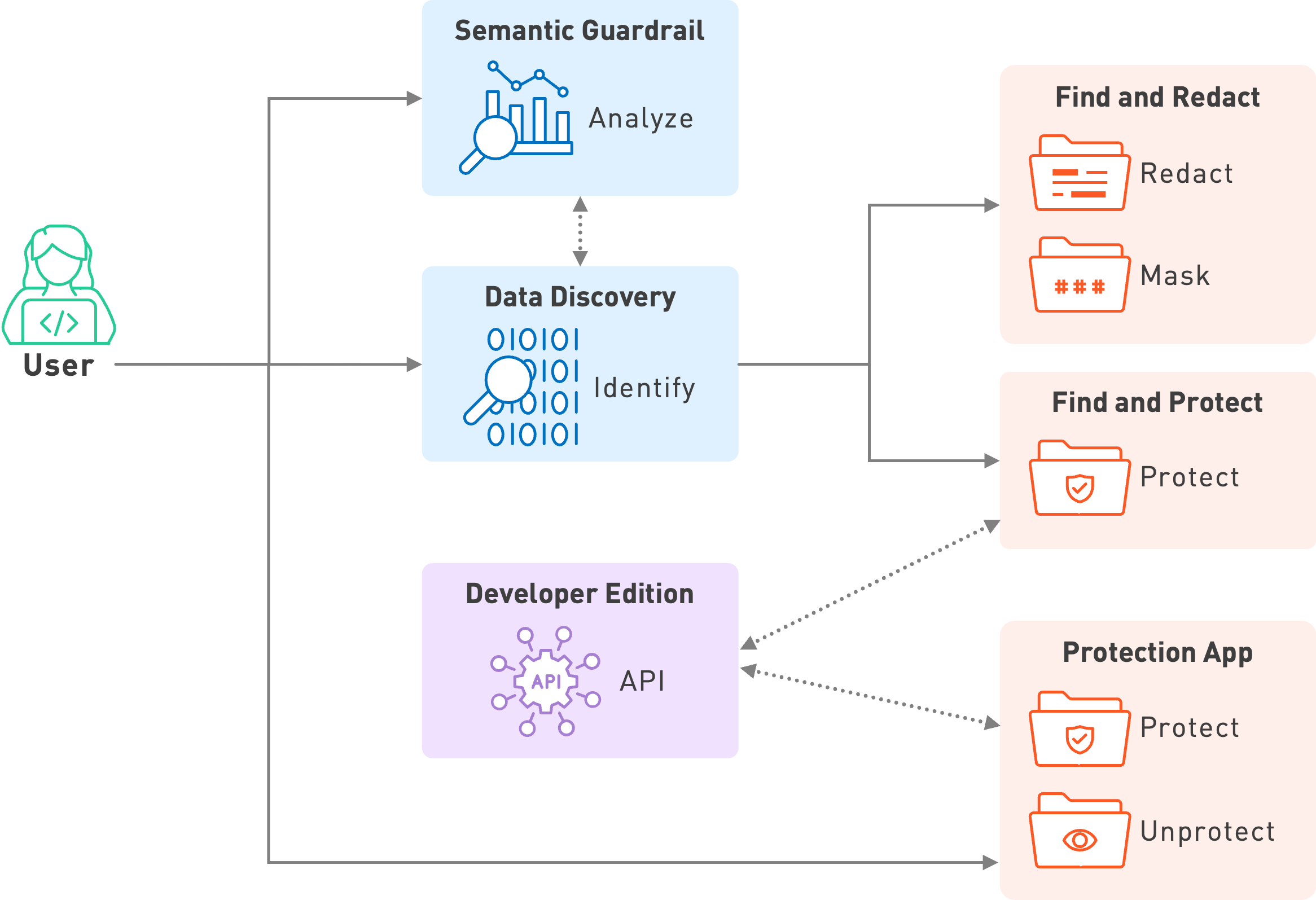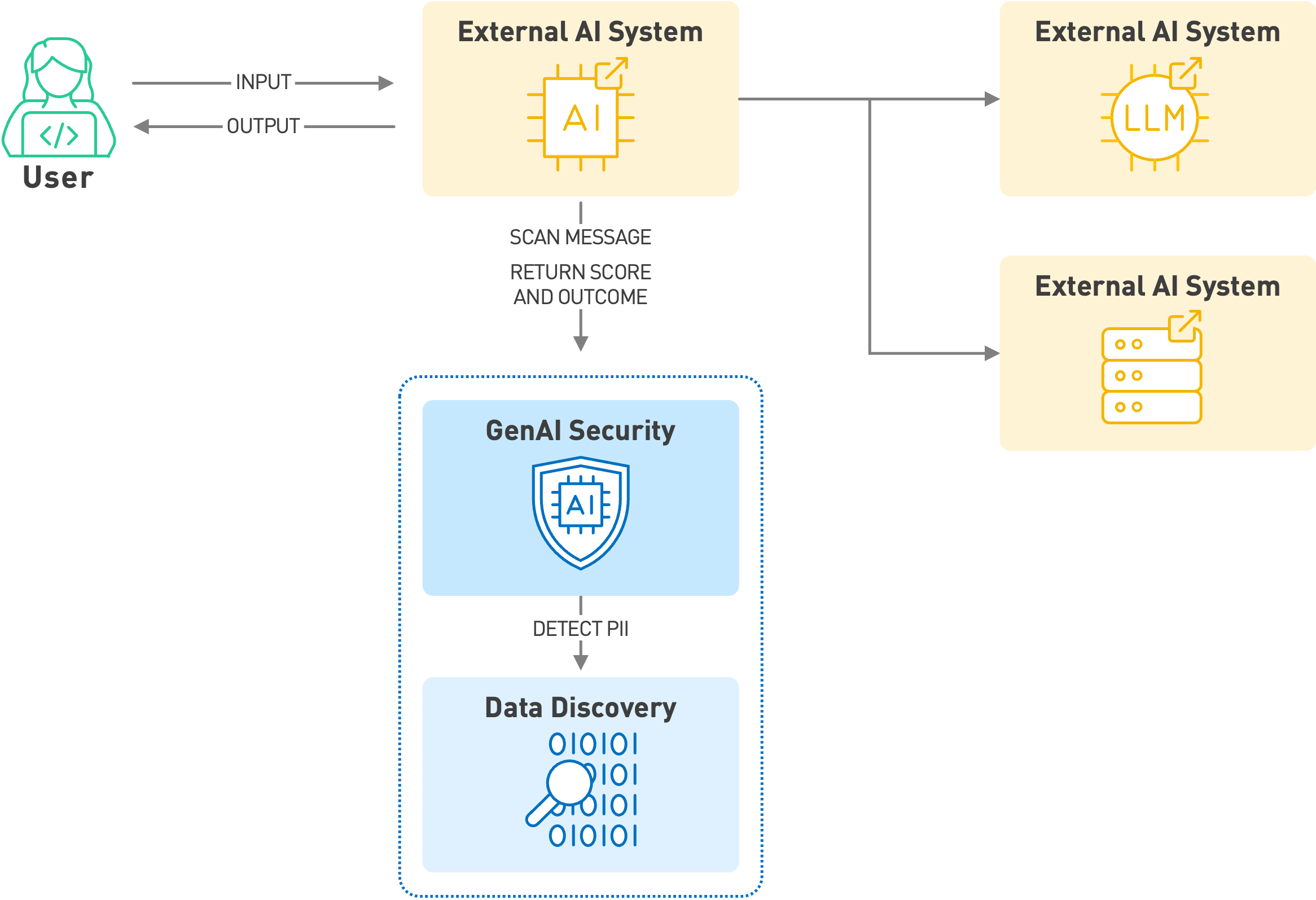Introducing Protegrity Developer Edition
Developers are under pressure to build and test new workflows quickly, often with sensitive data. As soon as real customer or financial information is introduced, projects slow down because of compliance, risk, and governance concerns. Identifiers like account numbers, claims records, or health data can’t safely flow through pipelines or models without protection. Developer Edition addresses this by giving developers the first enterprise-grade, governance-based Python package to apply tokenization and masking—enabling secure, trustworthy AI pipelines in minutes, not months.
In addition, Protegrity Developer Edition introduces Semantic Guardrails—runtime protections that inspect prompts and outputs for sensitive entities, ensuring that data is handled safely throughout AI interactions. These guardrails also evaluate risks in GenAI chatbots, workflows, and agents using advanced semantic analytics and intent classification to detect potentially malicious messages.
We’re excited to announce that Protegrity Developer Edition will be released on September 30, 2025.

Developer Edition Features
Developer Edition is designed for technical users building secure and well-governed data workflows. It installs directly from GitHub and installs and runs in under 30 minutes. Instead of complex enterprise setups, it leverages containers and a Python SDK to enable rapid prototyping immediately. The Developer Edition provides data discovery and data protection APIs letting developers integrate Protegrity functionality directly into their pipelines. These integrations carry forward into the commercial Protegrity platform—allowing data engineers and AI teams to scale from prototype to production securely and without rewrites.
This approach lowers the barrier for experimentation. It lets developers validate that data protection works with their real workflows, using tokenization and masking without worrying about infrastructure, key management, or full-scale governance policies.
This marks a shift in how security is applied to AI: rather than bolted on later, trust and compliance are built in from the start. Developer Edition helps teams ensure data preparation, transformation, and inference are all governed under consistent, enterprise-grade protections.
Semantic Guardrails 1.0
LLM-based apps come with real risks—private data leaking in responses, users slipping in prompt injection attacks, or AI-generated answers drifting into topics they shouldn’t touch. These aren’t edge cases anymore. They happen in production.

Semantic Guardrails help detect and stop those issues in real time.
They scan both the input and output of your GenAI workflows—chatbots, RAG systems, and agentic tools—and assign a risk score based on semantic context. That means they look beyond keywords to flag things like:
- Prompt injection attempts
- PII exposure
- Off-topic or adversarial prompts
- Malicious content or misuse patterns
You can block or redact risky content, log events for auditing, and apply different rules depending on user roles. Everything runs modularly in Docker and integrates with your existing pipeline.
Semantic Guardrails bring policy-driven trust to AI—without slowing development down.
Example Workflows
The following example workflows illustrate how Developer Edition helps technical teams apply data protection seamlessly within real-world AI and analytics pipelines. These use cases demonstrate how tokenization and masking can be used to safeguard sensitive information—without slowing down development or sacrificing model utility.
- Fraud detection: Connect AI models to transaction logs, tokenizing account numbers while still enabling anomaly detection. Guardrails ensure no identifiers leave the pipeline.
- Customer service assistants: Prompts containing personal details are intercepted and masked before reaching the model. Outputs are filtered so agents or customers never see leaked data.
- Credit scoring: Test AI scoring workflows on masked or tokenized data, validating accuracy without compliance risk.
Who Developer Edition Is For
Developer Edition is built for technical practitioners who need to test protections quickly and in context:
- Developers and ML engineers working in Python or CLI who want to add tokenization, masking, and discovery into prototypes. They can call the Find & Protect APIs directly, validate pipelines on protected data, and see how format-preserving encryption affects joins and lookups.
- Data architects who need to confirm how protected values behave across storage layers and query engines. They can test workflows end-to-end—moving masked or tokenized data between data lakes, warehouses, and vector DBs—without a full enterprise deployment.
- Security architects who must prove compliance controls work. They can review log files, test role-based reveal rules, and validate that masking policies hold up across query and output scenarios.
- MLOps engineers who manage training and inference pipelines. They can embed protection APIs in CI/CD jobs, validate how guardrails behave in model-serving frameworks, and ensure sensitive fields are never written to logs or checkpoints.
- Platform engineers responsible for infrastructure and deployment. They can test how Protegrity services integrate with Kubernetes, vector databases, and message queues while keeping keys and policies externalized.
Target Verticals
Developer Edition is built to meet the needs of organizations operating in highly regulated industries, where strict data protection requirements are essential. Below are some of the primary verticals that benefit from fast, integrated tokenization and masking capabilities as they build and test sensitive data workflows:
- Financial services: fraud detection, AML, and credit risk workflows where PCI and GLBA data must stay protected.
- Healthcare: claims summarization, diagnostics, and patient engagement pipelines that handle PHI under HIPAA and GDPR.
- Retail: recommendation engines and analytics workloads where PII and payment data must comply with PCI DSS and GDPR.
How to Start
Developer Edition GA was released on September 30, 2025. Downloads and documentation are available on the Protegrity Developers site here.
- Install from GitHub. Link here.
- Use the CLI and Find & Protect APIs to secure data.
- Try Semantic Guardrails 1.0 in your AI workflows.
Demo Walkthrough
Dan Johnson, one of our expert software engineers, demonstrates how to access, configure, and use the Protegrity Developer Edition, including setup, sample app, and Python SDK for data redaction.
Steps covered in the demo:
- Clone the GitHub repo.
- Check prerequisites (Python, pip, Docker).
- Configure Docker and start services with Docker Compose.
- Create a Python virtual environment and install the SDK.
- Run the sample app to see redaction of sensitive data in action.